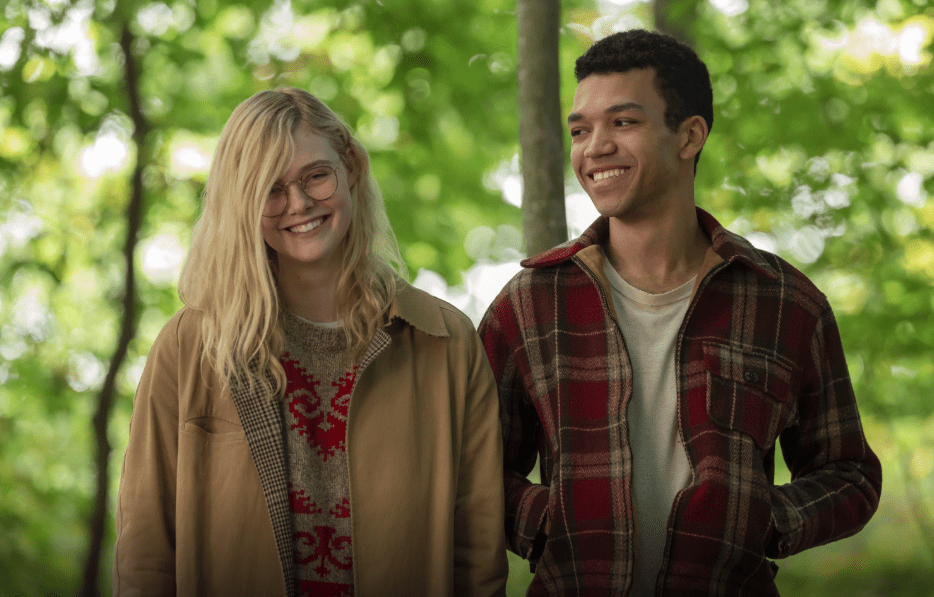
Netflix is slowly becoming one of the go-to suppliers of quality romantic media. Whether it’s silly rom-coms like the Christmas Prince movies or the darker, more twisted world of the hit series, You, the streaming service has a pretty good track record. Perhaps its most notable franchise, though, is the To All the Boys I Loved Before series. While the first film was a hit, its sequel didn’t garner quite as much acclaim. However, this week sees the release of another teen romance, All the Bright Places, and while it’s not nearly as light and sweet as those films, it’s still good enough that it may just become a modern classic too.
Adapted by Jennifer Niven and Liz Hannah from Niven’s novel of the same name, the films starts with a pretty shocking meet-cute: out for a morning jog in his small Indiana hometown, high schooler Theodore Finch (Justice Smith) comes to halt when he sees classmate, Violet Markey (Elle Fanning) poised on the railing of a bridge. He eventually talks her down off that ledge and quickly convinces her to partner with him on a class project that requires them to “wander” through interesting places. As Finch drags Violet to one strange locale after another, he helps her cope with her grief over her sister’s death in a car crash months earlier even as his own struggles with depression begin to impact their relationship.
Though the plot could easily feel overwrought, Fanning and Smith keep the material grounded even when their Virginia Woolf-quoting characters can feel too sophisticated for real teenagers. Smith is incredibly charming from the start. From the way he first gets Violet’s attention through an Instagram video, to the way he plays off being caught trying to use a grandmother’s death as an excuse for his school absences for the fifth time by joking that, “She’s our miracle,” his wry, relaxed wit draws us in. Fanning, on the other hand, is so standoffish at the beginning that it’s easy to understand just how deep Violet is in her grief, but it also makes her slow climb out of that depression that much more thrilling. When Violet finally laughs for the first time, finally allowing Fanning to unleash her megawatt star power, it feels like a reward for Finch’s persistence.
While Fanning and Smith are certainly some the best and brightest actors of their age group, it also helps that their beauty–and the promise it represents–is so emphasized throughout. First, there’s the costuming. Smith wears one flattering flannel after another, each perfectly tailored to emphasize his lithe handsomeness. Fanning, meanwhile, wears a series of gorgeous overcoats that, admittedly, can seem too fashionable for both their circumstances and their ages. A crushed pink coat Violet wears on of the wanders seems particularly out of place, but that sudden splash of color after so much beige is also such a lovely expression of her protective shell slowly cracking open that it’s easy to forgive.
That said, that moment wouldn’t be so effective if it weren’t one of the many beautiful images director Brett Haley and cinematographer Rob Givens deliver throughout. Shot in 2.39:1, aka the same ratio as Cinemascope, every frame is interesting, simultaneously following the characters’ story while also constantly establishing a sense of place. Locations are vital to the story and each one seems gorgeous and special. The highest point in Indiana may seem “lame,” but it’s also surrounded by lush woods filled with almost incandescent patches of light filtered through leaves. There and elsewhere, the way Givens uses natural light is striking in its beauty and it makes every image seem warm even though the character’s clothing suggests how cold the late winter/early spring weather still is.
Indeed, the images are testament to the fact that weather can be both bright and cold at once because these children can be both bright and cold at once. Every moment of happiness is also tinged with their sadness, their loneliness, their suppressed fears of their own darkness. In the hands of less skilled young actors, these kids could seem too morose, like clichés of sad teens. Instead, Fanning and Smith make them seem like real kids living through the worst parts of their lives, the kind of times you think of when you hear the mantra, “it gets better.”
However, as the film goes on, the less sure the viewer becomes that these kids will get to learn the truth of that statement. Even without having read the book beforehand, teen dramas follow certain tropes and the more fraught Violet and Finch’s relationship becomes, the more likely it seems the film will follow the toughest of those tropes. It would be unfair to spoil what direction the film goes, but it’s fair to say the ending packs just as much emotion as the rest and Fanning and Smith do some of their finest work to date.
The truth is, All the Bright Places isn’t the kind of teen love story everyone will enjoy. It deals with tough subjects like grief and depression and it’s well-made enough to make those themes incredibly affecting. Perhaps it’s not the light rom-com those disappointed by the To All the Boys sequel might be looking for, but it’s still something special.

